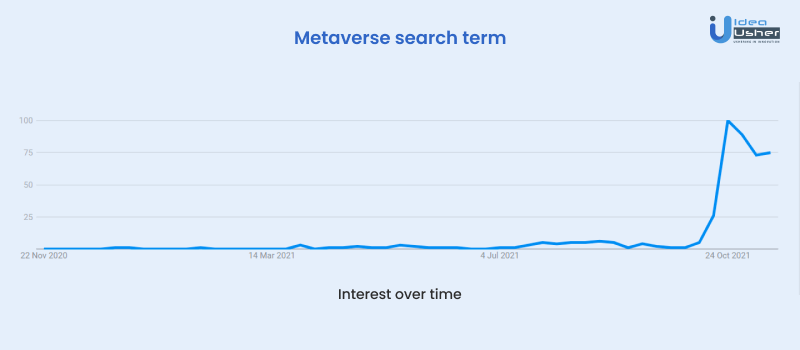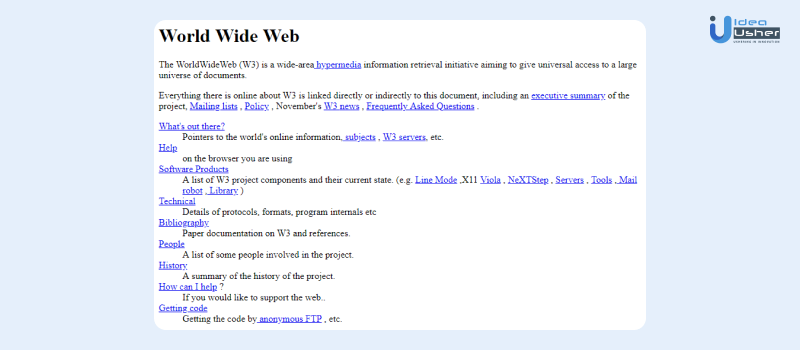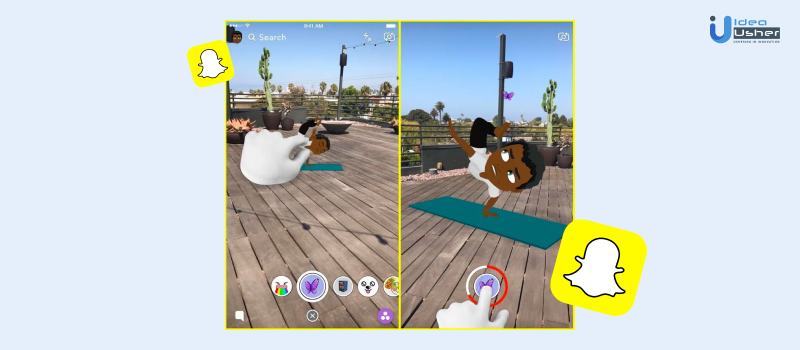The Metaverse has been in discussion for the past few weeks now. Trending in almost all social media platforms, the term “metaverse” has become one of the most searched keywords on Google.
Although the metaverse is nothing new, Mark Zuckerberg’s open acknowledgment of the same has surely had an effect on Facebook’s share prices.
So, is this some kind of an imagined version of the future like flying cars? Or is this really as inevitable as the wild west was during independence? Whichever it is, marketers should be aware of what is coming their way and be prepared to change their game accordingly.
Let’s have a look at exactly how popular the term “metaverse” has become in the last few weeks:
Google Trends: the search for the keyword “metaverse” peaked in late October and has been on a general uptrend for the last 12 months.

Twitter: #metaverse has 500+ tweets, and the numbers continue to climb.
Instagram: #metaverse has 144k posts.
Google News: In accordance with Google trends, searches in google news also are in a general uptrend which peaked in late October.
LinkedIn: More than 6500 people are already using the term “metaverse” in some way as their current, or past experience.
What is the Metaverse?

Metaverse is a combination of web 3.0, blockchain technology, virtual reality, and augmented reality. The intersection of these technologies will allow us to create complete virtual worlds filled with all kinds of content.
With the introduction of 5G across the world, VR and AR will be some of the few media types added to this phase of the internet. Thirty years ago, we saw the inception of the internet and web 1.0 where a website sort of looked like this:

Then came web 2.0, which allowed us to view and interact with videos on platforms like YouTube. Brands realized that having a website is as important as having a store.
Then came the later phase of web 2.0, where social media platforms like Facebook, Twitter, Instagram, Snapchat, and other social media companies made it possible for businesses to exist online completely without maintaining a store or a physical presence.
The next phase is web 3.0, where brands and social media companies will focus on new media types just like they did on video at the beginning of web 2.0. This time it’s VR and AR.
Facebook has recently announced itself as a “metaverse” company and has changed its name to Meta. Although experts like Tara Swisher have said that “the jury is still out”. The conjecture is that Apple and Google are more likely to be the leaders of the metaverse technology space.
Nevertheless, marketers should be aware of what is coming their way and be prepared for a technological shift.
How should marketers prepare for Marketing in Metaverse?

According to Wikipedia, the entire metaverse will be a combination of virtual reality, augmented reality, and the internet. This will make sure that you get a feeling of presence even in the virtual world.
Every single user will have a digital avatar that he/she can customize according to his/her choice.
Brands like Nike can start selling the metaverse NFT version of their AirJordans. And other brands can sell merchandise that is completely meant for the virtual world. This is not unexpected because we have already seen virtual NFTs like gun skins sell for a lot of money in games like Valorant, Fortnite, etc.
Companies should prepare by focusing on blockchain technology and creating a virtual presence in the metaverse. Marketers should also remember the influence of GenZ on household spending. This only highlights that marketing in metaverse should be focused on GenZ.
Is Facebook the only platform working on the Metaverse?
Facebook is not the only company working on metaverse technology. Snapchat, Google, Apple, Nvidia, Roblox, and others are also set to be significant players in the metaverse.
There are various engines like Unreal Engine, Unity, etc. who are already working with the technology.
In games like Fortnite, celebrities like Ariana Grande and Travis Scott have held virtual concerts which became extremely popular. Share on XThis only proves that if we were to advance this technology using VR, AR, and AI. it would mean creating an entirely new world, where all the things that can be done in real life can be replicated. A person sitting in Florida can attend a concert with his friend in NYC, whilst the celebrity is sitting in Washington state.
This gives immense scope for brands to advertise their products/ services to the world by embedding them into the metaverse.
Matt McGowan, Snap Director and General Manager Canada says:
“For brands and marketers, it’s important to remember the value of Gen Z and millennials – or the Snapchat Generation, as we like to call them.”
SEO and the Metaverse:
Brands have been optimizing their content to get found on search engines like Google, Bing, Yahoo, etc. This is possible because of an in-depth understanding of how search engine algorithms work.
We might see something very similar in the metaverse as well, with search engines being the gateway to this new world. Although it is hard to speculate on how exactly you can get found on the metaverse. It is quite possible that having the word “metaverse” in your brand name might help.
Deep content is the crux of SEO. Content that best serves the user’s needs will always beat the rankings of its competitors.
Images, videos, infographics are all brilliant types of content that drive rankings up. As the search engines are becoming more capable at reading and understanding your content, higher quality content will naturally be rewarded over poorer work.
Marketing in metaverse should be done with an overview of their current strategy and marketers must try to implement more VR, AR, and 3D content in their strategy.
Metaverse and social media:
Facebook recently announced its agenda of turning into a metaverse social media company rather than staying a conventional social media camp company as it is at present.
With brands such as Oculus (which makes hardware) and a platform like Facebook Horizon (which is software-based), Facebook is now ready to shift from 2D to 3D. This shift is going to be monumental when it comes to the social media evolution of web 3.0.
Mark Zuckerberg has recently pointed out that in Facebook metaverse users will be able to create a completely virtual avatar that will give a sense of being and presence which current technology like screens are unable to simulate. The use of VR in social media is going to be fairly common in the near future.
Snapchat is also working with metaverse technology and is expected to implement the same sort of technology into its business profile. There is no denying that marketing in metaverse will be heavily influenced by social media.
Facebook’s metaverse:
Facebook metaverse will be dependent on two things primarily, one is the Oculus headset and the other is the Facebook Horizon.
When the user enters Horizon he/she will be able to visit different worlds revolving around a specific niche/ interest. Just like people visit different websites with different niches.
Gamers can visit gaming worlds while people interested in learning meditation can do the same via VR meditation Facebook groups.
You will be able to share media like videos, audio, images, etc., on Facebook groups. You will even be able to create your own world on the metaverse using Horizon.
What will you need to enter the metaverse?
You just need the following things-
- Oculus VR headset,
- Oculus account, and
- Facebook Horizon account.
Snapchat’s metaverse:

Snapchat is also aiming to be one of the leading companies in the metaverse technology space. The free lens web builder tool on Snapchat is a great way to get started with Augmented Reality.
The tool is an easy and quick way to create AR lenses using a pre-selected combination of 3D metaverse assets.
Snapchat trends is another tool that has recently been released and helps the users better understand the words and phrases trending on Snapchat. This allows brands/ influencers to gain more visibility by leveraging the data.
Snapchat Specs and Bitmojis:

With the beta launch of its 3D spectacles, Snapchat is trying to push the limits of 3D content on social media. This will, with time, give rise to creators and influencers who are primarily 3D content-based.
The digital avatar concept is just not a Facebook thing, Snap has already made it possible for its users to make a digital version of themselves with custom clothing and appearance so that you can interact on the platform as a digital version of yourself. These avatars are called Bitmojis.
Public relations and the metaverse:
Companies are entering the metaverse and NFTs are a big part of it. NFTs are making it possible to buy/sell or trade goods completely digitally.
Easy ways to use AR and VR for brands:
- Create AR content.
- Attend VR events/ concerts on Facebook Horizon. This will give you a better idea of how VR events are being held and how you can do it differently.
- Collaborate with influencers in the metaverse space to increase visibility.
- Start interacting with media personnel who cover VR/AR and the metaverse.
- Use AR to create PR content that stands out.
Conclusion:
Standing at this junction in technological evolution, it is really important for brands, companies, and influencers to get started with virtual reality, augmented reality, and 3D content as soon as possible.
Leveraging an early bird advantage in the space can really help brands get the exposure they need. Virtual beings are already in our daily lives like Siri, Alexa, and Google. This shows us that the brain of the metaverse is already there, it is just waiting to turn 3D.
Unlike the internet, the metaverse won’t take 30 years to reach everyone. The internet took that long because of logistics. The metaverse being completely digital in nature, won’t take more than the next 10 years to exist in everybody’s life in some form or the other.
People will quickly shift to the virtual world easily because they can use/ own/ attend things that they couldn’t have in real life, like a fancy jacket or a vintage car. This creates immense opportunities for marketers to advertise their products sooner, better, and across geographical boundaries.
FAQ:
1. How much is the metaverse worth?
The metaverse is worth around $82 Billion. A little less than Facebook’s last year’s revenue.
2. Is metaverse virtual reality?
The metaverse is an amalgamation of virtual reality, augmented reality, blockchain technology, and web 3.0. It is a computer-generated parallel world.
3. Who is investing in metaverse technology?
Facebook, Microsoft, Unity, Roblox, Nvidia, Autodesk, and other such big corporations are investing in the metaverse.
4. What are some of the brands that have launched in the metaverse?
Brands like Balenciaga, Rebecca Minkoff, Carli Cohen, and others have already launched in the metaverse.






















